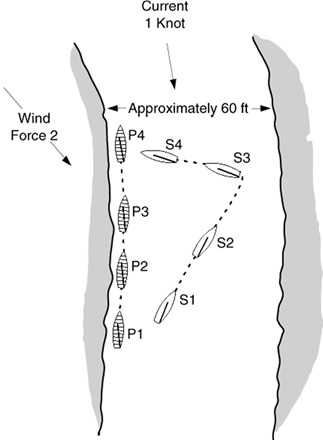



CASE 43
Definitions, Clear Astern and Clear Ahead; Overlape
Rule 10, On Opposite Tacks
Rule 14, Avoiding Contact
Rule 19.2(b), Room to Pass an Obstruction: Giving Room at an Obstruction
A close-hauled port-tack boat that is sailing parallel and
close to an obstruction must keep clear of a boat that has
completed her tack to starboard and is approaching on a
collision course.

Facts
P is sailing up-river, close-hauled on port tack, very close to the bank. S,
unable to point as high as P, is forced to sail away from the bank. She then
tacks onto starboard and immediately hails ‘Starboard’ to P. P sails on and,
when she reaches a position at which she cannot luff without hitting the bank
or bear away without colliding with S, she hails S for room.
Question
Which rule or rules apply?
Answer
P is subject to rule 10 and must keep clear. P is also required by rule 14 to
avoid contact if reasonably possible. S establishes right of way over P when
she tacks onto starboard, but must observe rules 13 and 15. S meets rule 13’s
requirement by not tacking so close that P has to take avoiding action before
S reaches her close-hauled course. After S acquires right of way over P
under rule 10, S complies with rule 15 by initially giving P room to keep
clear.
Rule 19.2(b) does not apply because S and P are on opposite tacks, are not
both sailing more than 90 degrees from the true wind, and so are not
overlapped at positions 3 and 4 (see the last sentence of the definition Clear
Astern and Clear Ahead; Overlap). Rule 20 does not apply because P and S
are not on the same tack. Therefore, S is not required to give P room in
response to P’s hail for room. However, after it becomes clear that P is not
keeping clear, rule 14 requires S, if it is reasonably possible, to avoid contact
with P. S would risk disqualification if there were contact that caused
damage or injury.
GBR 1978/5






